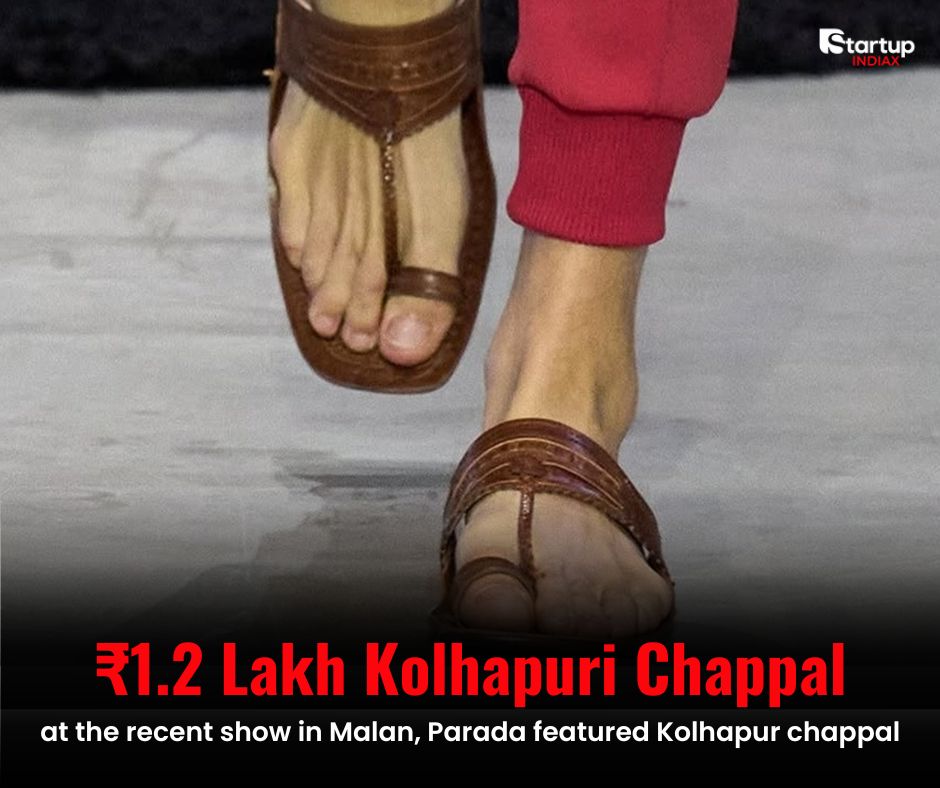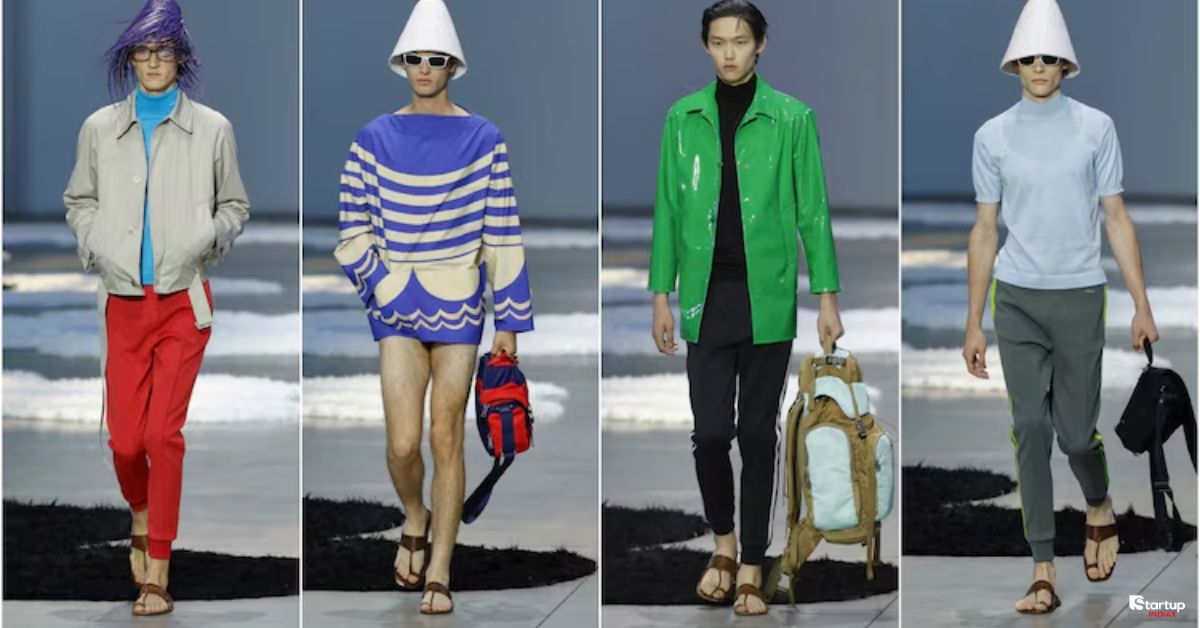Summary
Kolhapuri chappals at Milan fashion show have sparked a heated debate after Prada showcased leather sandals priced at ₹1.2 lakh, strikingly similar to India’s iconic Kolhapuri chappals, without crediting their cultural origins. This article, published by Startup INDIAX, explores the heritage of Kolhapuri chappals, Prada’s controversial move, and the broader issue of cultural appropriation in fashion. Readers will learn why this matters, how India is reacting, and what can be done to honor traditional craftsmanship. Discover the story behind the controversy and how to support Indian artisans.
Table of Contents
What Are Kolhapuri Chappals and Why Are They Special?
Kolhapuri chappals are more than just footwear; they’re a symbol of India’s rich cultural heritage. Originating from Kolhapur, Maharashtra, these handcrafted leather sandals have been worn for centuries, blending style, durability, and tradition.
The Cultural Roots of Kolhapuri Chappals
Kolhapuri chappals trace their origins to the Chamar community in Maharashtra, skilled artisans who have perfected leatherworking over generations. These sandals, often adorned with intricate stitching and vibrant dyes, reflect a deep connection to Indian craftsmanship. According to a 2023 report by the Indian Handicraft Export Council, Kolhapuri chappals contribute ₹150 crore annually to India’s handicraft economy, supporting thousands of artisans. Their timeless design has made them a staple in Indian fashion, worn by everyone from villagers to celebrities.
How Are Kolhapuri Chappals Made?
Crafting Kolhapuri chappals is a labor-intensive process. Artisans use vegetable-tanned leather, hand-cut and stitched with precision. The process, which can take up to a week per pair, involves no machinery, relying entirely on traditional tools. “Each pair tells a story of skill and patience,” says Anil Patil, a third-generation Kolhapuri artisan from Kolhapur. The sandals are eco-friendly, using natural materials, and are known for their durability, often lasting years with proper care.
Why Did Prada’s Milan Show Spark Controversy?
Prada’s Spring/Summer 2026 collection at Milan Fashion Week featured leather sandals that bore a striking resemblance to Kolhapuri chappals, priced at an astonishing ₹1.2 lakh. The lack of acknowledgment of their Indian roots ignited widespread criticism.

What Happened at Prada’s Spring/Summer 2026 Show?
During the Milan Fashion Week in June 2025, Prada unveiled a collection that included tan leather sandals with open-toe designs and braided patterns, nearly identical to traditional Kolhapuri chappals. Social media posts on X highlighted the similarities, with users calling out Prada for profiting off a design rooted in Indian tradition without giving credit.
How Did Prada Present the Kolhapuri-Inspired Sandals?
Prada marketed these sandals as a “luxury leather sandal,” emphasizing their minimalist aesthetic and high-end craftsmanship. However, the brand’s failure to mention Kolhapuri chappals or their Indian origins drew accusations of cultural theft. Fashion critic Meera Sharma noted, “Prada’s silence on the inspiration behind these sandals erases the legacy of Indian artisans who’ve perfected this craft for centuries.”
Is This Cultural Appropriation or Appreciation?
The Prada controversy has reignited discussions about cultural appropriation versus appreciation in the fashion industry.
What Is Cultural Appropriation in Fashion?
Cultural appropriation occurs when elements of a marginalized culture are used by a dominant culture without permission, context, or credit, often for profit. According to a 2024 study by the Fashion Institute of Technology, 68% of global fashion brands have faced backlash for appropriation in the past decade. Prada’s case fits this pattern, as the brand profited from a traditional Indian design while ignoring its cultural significance.
Why Does Giving Credit Matter?
Giving credit acknowledges the history and labor behind a cultural artifact. For Kolhapuri chappals, crediting the Chamar community and Indian artisans ensures their contributions are valued. “When brands like Prada borrow without acknowledgment, they strip away our identity,” says Priya Deshmukh, a cultural historian. Proper credit can also drive economic opportunities to artisans, fostering sustainable growth.
How Has India Responded to Prada’s Actions?
The backlash against Prada has been swift, with Indian netizens, designers, and activists voicing their concerns.
What Are Social Media Reactions Saying?
Posts on X reveal widespread outrage, with users labeling Prada’s actions as “cultural theft” and “colonial couture.” One user wrote, “Prada’s ₹1.2 lakh Kolhapuri chappals are a slap in the face to Indian artisans who sell them for ₹500.” Another called for a boycott, urging consumers to support local craftsmen instead. These sentiments reflect a growing demand for accountability in global fashion.
How Can Indian Artisans Be Supported?
Supporting Indian artisans starts with buying authentic Kolhapuri chappals from local markets or certified cooperatives like the Kolhapur Artisan Collective, which ensures fair wages. Startups like Startup INDIAX are also amplifying these stories, connecting consumers with artisans through their platform. Additionally, campaigns like #BuyLocal and #SupportIndianCrafts are gaining traction, encouraging ethical consumption.
What Can Be Done to Prevent Cultural Theft?
Preventing cultural theft requires action from both brands and consumers to foster ethical fashion practices.
How Can Brands Be More Ethical?
Brands like Prada can adopt transparent sourcing and crediting practices. Collaborating with local artisans, as seen with Indian brand Sabyasachi’s partnerships, ensures fair compensation and cultural respect. A 2025 report by the Ethical Fashion Initiative suggests that brands adopting such practices see a 20% increase in consumer trust. Prada could issue a public acknowledgment and partner with Kolhapuri artisans to rectify the situation.
What Role Do Consumers Play?
Consumers wield significant power by choosing brands that respect cultural heritage. Researching product origins, supporting ethical labels, and calling out appropriation on platforms like X can drive change. “Every purchase is a vote for the kind of world we want,” says fashion activist Rhea Kapoor. By prioritizing authenticity, consumers can uplift marginalized artisans.
Conclusion: Standing Up for Cultural Heritage
The Kolhapuri chappals at Milan fashion show controversy highlights the need for respect and recognition in global fashion. Prada’s failure to credit India’s artisans has sparked a vital conversation about cultural appropriation, but it’s also an opportunity for change. At Startup INDIAX, we’re committed to sharing stories that celebrate Indian innovation and heritage. Share your thoughts in the comments, explore more startup stories on our platform, or join the movement to support local artisans. Together, we can ensure cultural treasures like Kolhapuri chappals are honored, not exploited.
FAQs
What are Kolhapuri chappals?
Kolhapuri chappals are handcrafted leather sandals from Kolhapur, Maharashtra, known for their durability, eco-friendly materials, and intricate designs.
Why is Prada being criticized for their Milan show?
Prada showcased sandals resembling Kolhapuri chappals at their Spring/Summer 2026 show without crediting their Indian origins, sparking accusations of cultural appropriation.
How can I support Kolhapuri artisans?
Buy authentic Kolhapuri chappals from local markets or cooperatives like the Kolhapur Artisan Collective, and support campaigns like #BuyLocal.
What is cultural appropriation in fashion?
It’s when a dominant culture uses elements of a marginalized culture without permission or credit, often for profit, erasing the original context.
Can Prada fix this controversy?
Yes, by publicly acknowledging the inspiration, collaborating with Indian artisans, and adopting ethical sourcing practices.

